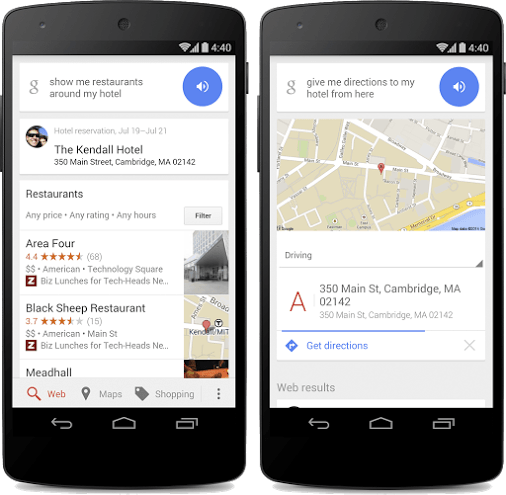Whether it’s Apple’s Siri, Samsung’s S Voice, or Microsoft’s Cortana, intelligent personal assistants have become a part of our daily lives when performing tasks or surfing online. But out of all the intelligent personal assistants, Google Now appears to be the most promising.
Rumors of Google’s version of Siri first began floating around in late 2011. Originally codenamed Majel after “Star Trek” actress Majel Barrett-Roddenberry – she was the voice of the computer onboard system for the TV series and wife of creator Gene Roddenberry – the new voice assistant was rumored to debut in January or February 2012. According to one early tipster, Google’s Project Majel was “definitely as good, or better, than Siri.” Google Now was unveiled at the Google I/O during the premier presentation of Android 4.1 Jelly Bean on June 27, 2012.
Before 2012 was over, Google Now was named “Innovation of the Year” by Popular Science.
 Image Source: Wikipedia
Image Source: WikipediaBut What Exactly Does Google Now Do?
Google Now does more than just answering questions or providing recommendations. It’s literally a virtual personal assistant. If you have tickets to a football game, it will send you everything from weather updates to traffic conditions. Even after the game, it can help you remember where you parked your car. Google Now can gather this information based on your location and search history, which are then stored on specialized cards.
As updates have continued to roll in, Google Now can also achieve tasks while traveling. For example, Google Now scans your Gmail account and discovers that you are out of town because there’s a hotel confirmation. You can then ask Google Now where to eat or visit based on the location of your hotel.
There endless possibilities with Google Now since it works with other Google features. And most intriguing is how Google Now is changing online interactions.
Predictive Search
Before we get too far, what exactly is predictive search? WordStream simply describes this feature as “a predictive search algorithm based on popular searches to predict a user’s search query as it is typed, providing a drop down list of suggestions that changes as the user adds more characters to the search input.” This is important because people read faster than they type, so this is a major time saver.
However, it’s not exactly new.
Back in 2004, Google first experimented with predictive search with Google Suggest – which was renamed Google Autocomplete in 2010. Google Instant arrived in 2010 as well, which teamed up with Autocomplete to give users an advanced predictive search feature.
With Google Now, predictive search is becoming more personalized. Since Google has access to your information (with your permission, of course), you can receive information that relates just to you. It could be anything from a flight itinerary to local news to baseball scores to stock reports.
In short, Google Now is basically a personal assistant that will get you anything you want without ever having to ask for it. So, if you email your team every morning with reminders, Google Now could start doing that for you. In other words, you may someday be able to interact with people without even having to utter a single word.
SEO Benefits
As we just mentioned, Google Now has access to a user’s search history, geo-location, and interests to deliver specific search results. This is really important for SEO. Marketers can now plan a strategic SEO strategy more easily and quickly than in the past.
Because of the information Google Now has access to, marketers could also use that information to learn more about their audience and how to get in touch with them. So, brands may be able to interact with their audience more directly and specifically than ever before.
There are also the benefits for local SEO. Currently, half of all mobile searches are used in order to find a local business – with 61 percent resulting in a purchase. Furthermore, according to Search Engine Watch, 59% of consumers are using Google to find a local business.
By using Google Now, along with Google+ Local, businesses have a better opportunity to reach their intended audience, which in turn, will result in more conversions.
Connecting With People With Physical Disabilities
In 2010, it was announced that Google Now would be offering Heatlhmed’s neural communicator. The software gave people with physical disabilities the chance to search, surf online, or use any of Google’s features. However, if the capabilities of Google Now were combined with technology like Google Glass the possibilities would be endless.
This is already the case with the piece of wearable tech. US News covered the story of Ashley Lasanta, a 23 year-old with cerebral palsy. With Google Glass she is able to take pictures and then share them with others. She can also play games, send emails, search online, and even find recipes. Mark Perriello, president and CEO of the American Association for People with Disabilities, stated “Google Glass has a ton of potential to transform lives for people with disabilities.”
While Google Now is intended to make life easier for everyone, it could be extremely useful for disabled people to communicate with friends or family, plan their day or even have an emergency contact on standby. Imagine a friend or family member receiving an automatic notification every time their loved one leaves the home. It would definitely provide some peace of mind. And it’s already a feature with Google Commute.
Available Across Multiple Devices
Unlike Siri, which is only compatible on iPhones, Google Now can be used on both Android and Apple devices. Why is this important? Because just like Siri, Google Now has the ability to send text messages or emails through voice command. However, Google Now isn’t limited to one type of phone.
Apple should be just a bit concerned. All the features Google Now provides, not to mention the lack of sass that Siri offers, may be enough for people to rely less on Apple software.
While Google Now may not be enough to replace the iPhone, it remains a great business move for Google since fans of Google Now don’t have to just buy an Android device. In the long run, would this be enough for Apple to eventually allow Siri on Android devices?
The Internet of Things
Just in case you aren’t familiar with the term, here’s the best way to describe the internet of things according to Cisco:
“The Internet of Things (IoT) is the network of physical objects accessed through the Internet, as defined by technology analysts and visionaries. These objects contain embedded technology to interact with internal states or the external environment. In other words, when objects can sense and communicate, it changes how and where decisions are made, and who makes them.”
Google Now has the potential to completely integrate with the internet of things. For example, let’s say your fridge notices you’re low on eggs and adds them to your shopping list. Because your local grocery store is in your contacts, Google Now could take that information and automatically place an order.
Is that really far-fetched? You can currently hook-up your Android device to your smart TV and tap “Listen for a TV Show” Card to learn more information about the program you’re watching, such as trivia and profiles of the actors and actresses. If you’re already using Google Wallet, you can breeze through check-outs, track your purchases, and receive offers.
Google Now also finds listings for shows or movies starring your favorite actor or notifies you when you’re favorite store is running a special. These features will most likely sync with the internet of things in the very near future.
Sharing Information/Media
You’ve probably noticed that Google has been backing-up and sharing uploads automatically. For some, it’s an annoyance. for others, it’s a life saver knowing that their information is stored somewhere else in case something happens to their phone.
There could come a point when Google Now will know which type of information to share with certain people. Let’s say you’re on a family vacation. Instead of sharing picture or video with all of your contacts, it only sends that information to relatives. What if you finish a project for work? Google Now can send that document to the right contacts automatically.
It’s just these little features that make communicating with others go more smoothly and quickly.
Internet Connection Not Required
On a Google+ post from May 2, 2014, the following announcement was made:
“Next time you’re on the subway and want to check on your day’s appointments with Google Now, you won’t have to worry about lack of cell service. Starting today (make sure you update your #GoogleSearch App for Android http://goo.gl/idgt3y) your Google Now cards stay loaded, even when you lose service in the subway… or your favorite underground bar! “
This means if you’re at the airport and in a dead zone, you can still access your boarding pass. While you can still look at cards containing sports or news cards, that information won’t be updated until you have a connection. Still, it’s an interesting step forward in allowing people to stay online without really being online.
How do you think Google Now is changing how we interact online?
Featured Image Source: Google+





